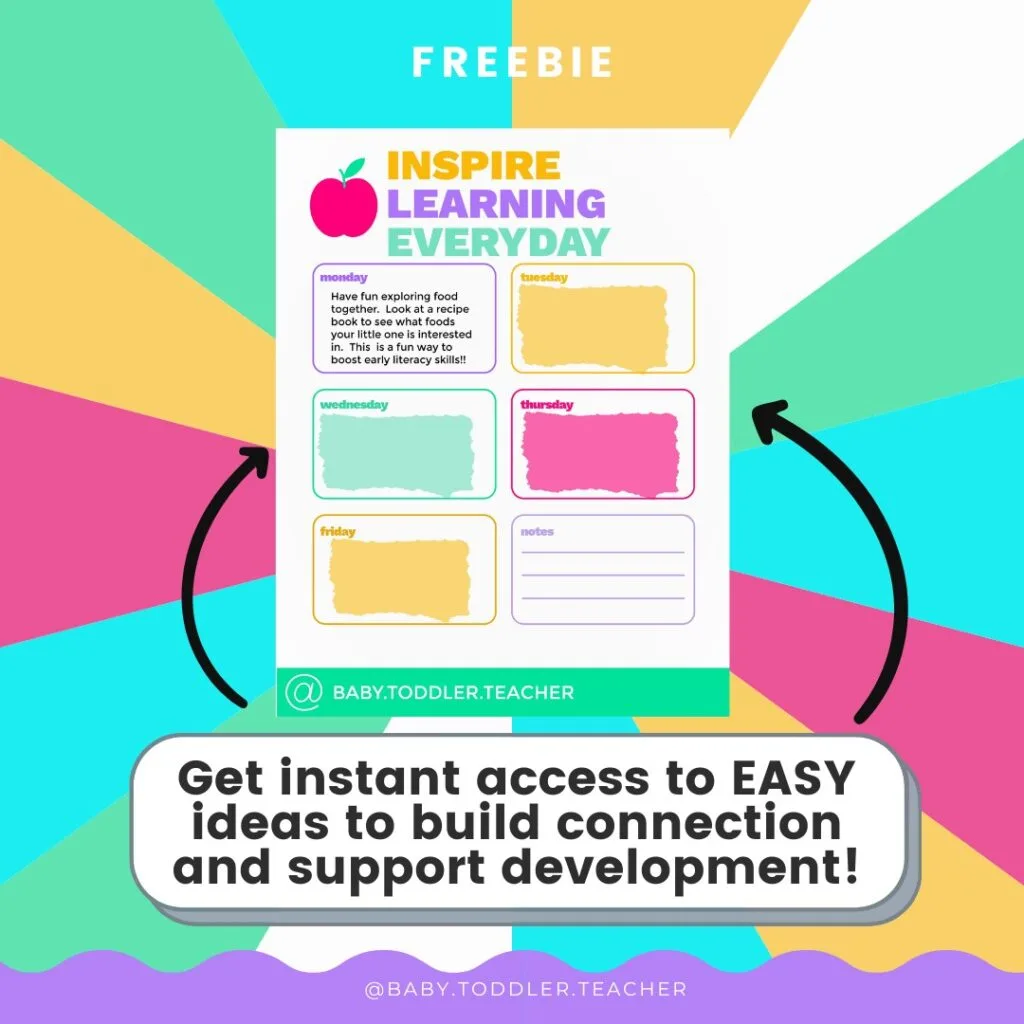Sensory play activities provide a fun and engaging way for our little ones to explore the world around them.
They stimulate a child’s senses – touching, smelling, seeing, moving, and even tasting, helping lay the groundwork for their cognitive, motor, and language skills.
This blog post is dedicated to busy caregivers of one-year-olds, offering easy and playful sensory activities that you can easily introduce at home.
So, let’s dive into a world of colors, textures, and joy to give your child a sensory-rich experience!
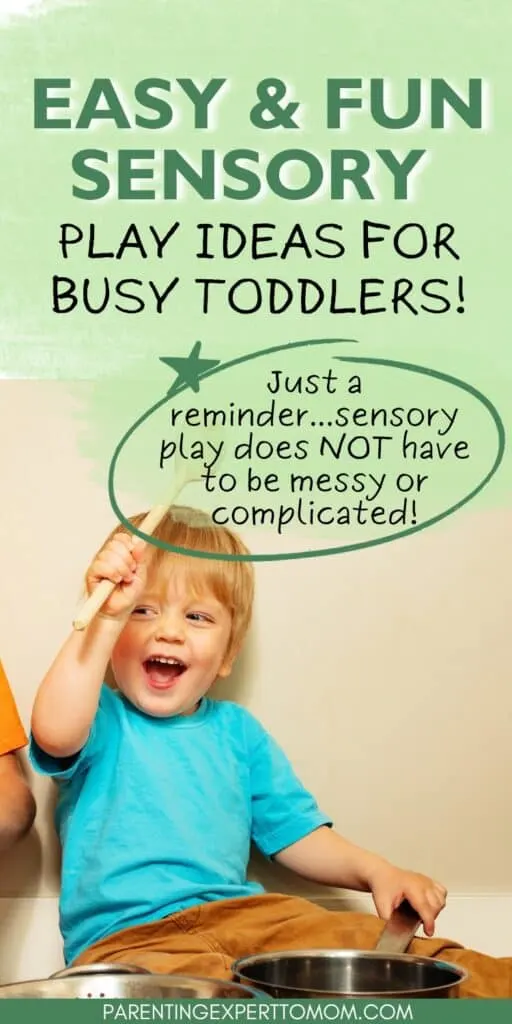
(This post may contain affiliate links. To read our full disclosure policy click here.)
Benefits of Sensory Play
Sensory play has numerous benefits, contributing significantly to the overall development of toddlers.
By engaging their senses, children strengthen their cognitive skills, enhancing their ability to observe, classify, and compare, which are critical for cognitive development.
This form of play also bolsters language skills, providing a context for language development as children learn to express their experiences.
Fine motor skills are another area that sensory play targets.
Manipulating small objects, molding playdough, or feeling the bark of a tree will help hone these skills.
Social skills also get a boost as children learn to share, take turns, and negotiate while performing sensory play activities with peers.
An often underappreciated benefit of sensory play is the enhancement of problem-solving skills.
When toddlers experiment with different materials in sensory play, they encounter problems and learn to find solutions, fostering their problem-solving ability.
Hence, sensory play is an integral part of a child’s early education, laying a solid foundation for their future learning journey.
Explore Different Sounds
Exploring different sounds, both inside and outside the home, is a great way to stimulate the sense of hearing for our young children.
With the world buzzing with a myriad of sounds, every noise can be a learning opportunity.
In the home, everyday objects can turn into musical instruments – a wooden spoon against a saucepan, the rustling of paper, or the tinkling of bells on a toy.
Outdoors, the chirping of birds, the rustling of leaves, or the gentle hum of traffic can all contribute to this sensory play.
Encouraging children to imitate these sounds is a great way to encourage language development as the imitation of sounds usually comes before words.
As children learn to associate sounds with words and actions, they develop critical listening and speech skills.
So, don’t hesitate to let your child explore the symphony of sounds around them – it’s a simple yet effective sensory activity.
Water Play can be a Fun Sensory Activity
Water play can be an extraordinary sensory experience for young kids, especially one-year-olds. The sensation of water flowing through their little fingers can be both calming and exciting.
A water table (like this), filled with different toys and objects, can transform into a world of discovery and exploration for them.
Don’t have a water table?
No problem! Even a simple cake pan filled with water will provide just as much fun.
By splashing, pouring, and stirring water, they can observe various concepts like cause and effect, volume, and weight.
These simple, yet fascinating experiences can significantly enhance their hand-eye coordination and fine motor skills.
Furthermore, the simple act of grasping and releasing toys in the water can help in muscle development in their hands.
Therefore, water play is not just fun for young kids, but an excellent tool for sensory development and learning as well.
Look for Easy Sensory Activities in Your Daily Routines
Everyday routines offer ample opportunities for sensory exploration if we are mindful.
For example, consider the simple act of washing fruits, such as strawberries, for your toddler.
This becomes a water play activity that encourages sensory development.
The cool sensation of the water, the unique texture of the strawberry, and the sound of water splashing create a multi-sensory experience.
Similarly, doing laundry can serve as a treasure trove of new textures.
Soft fabrics, rough denim, and fluffy towels provide a range of sensations for your little one to explore.
Sorting laundry based on texture can be a fun, sensory-rich game for your toddler.
Even a simple activity like setting the table can be transformed into a sensorial journey.
The clinking of cutlery, the smooth surface of plates, the soft napkins – all these contribute to sensory development.
The toddler years are a time of intense discovery, and every new thing they encounter enhances their understanding of the world.
Guiding them to explore, touch, listen, and observe in their day-to-day activities helps them build new skills, making everyday routines catalysts for their growth and development.
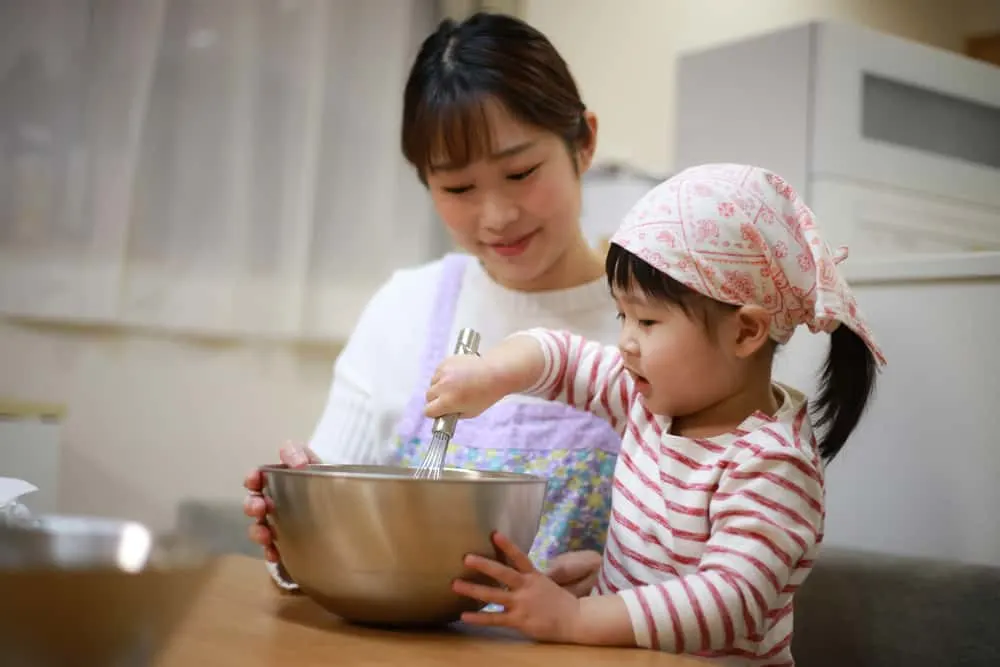
Baking as a Sensory Adventure
Engaging your toddler in baking activities can be a wonderful way to stimulate their senses and enhance their development.
The process of baking introduces a variety of textures, smells, tastes, sounds, and visual stimuli, making it an excellent sensory play activity.
This has always been a favorite activity that I have done with both of my kids starting early on.
To start, kneading or rolling out dough can be a fun and tactile experience for little hands.
The dough’s soft, pliable texture encourages fine motor skill development as your child learns to manipulate it.
Handling various baking tools, such as spoons, rolling pins, and cookie cutters, further enhances their motor skills.
Moreover, baking provides a feast for the nose.
The distinct aromas of different ingredients, from the sweet scent of vanilla to the strong smell of cinnamon, stimulate their olfactory senses.
Taking time to smell each ingredient before adding it to the batter can be a wonderful sensory experience.
Not to mention, the enticing aroma that fills the house when the baked goods are in the oven offers a delightful sensory reward, and tasting the end product is an enjoyable experience for the sense of taste.
By involving your child in the baking process, you are not just teaching them how to bake, but also providing an enriching sensory play experience.
Moreover, it’s a great opportunity for them to learn about cause and effect, fractions, and time, transforming your kitchen into a fun and informal classroom.
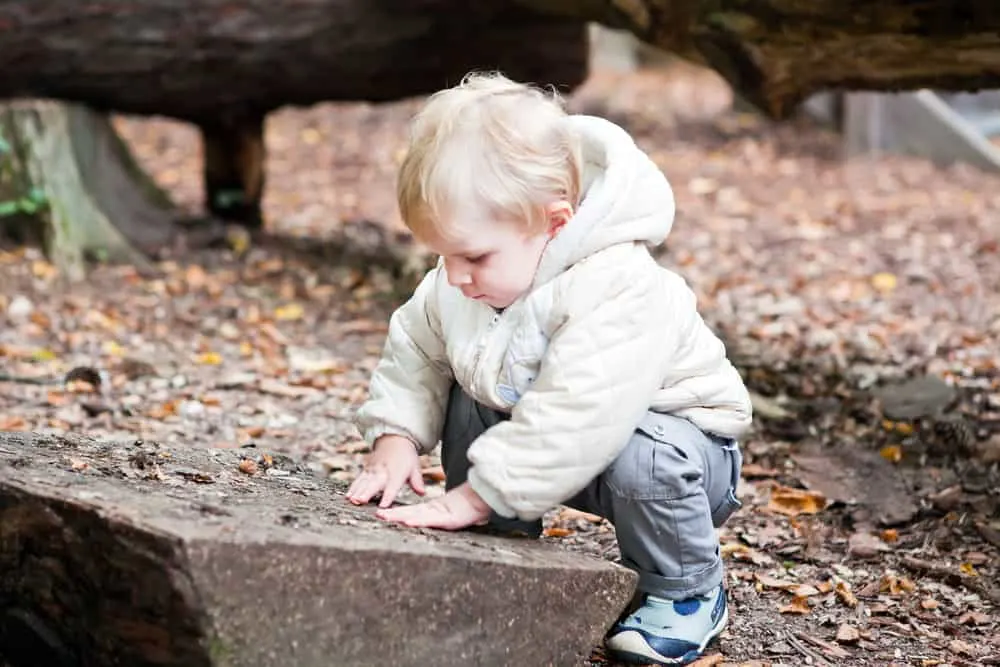
Sensory Experiences can be Found Outside
Stepping outside can transform everyday experiences into sensory-rich exploits for toddlers, presenting a world ripe for exploration.
The sensation of soft grass under little bare feet, or the thrill of crunching dried, autumn leaves in their tiny hands, serves as an introduction to the diverse textures that nature has to offer.
Jumping in puddles not only amplifies their joy but also acquaints them with the concept of cause and effect.
The symphony of chirping birds provides auditory stimulation, helping them discern different sounds.
Feeling the gentle caress of the wind on their skin brings awareness of atmospheric changes, enhancing their tactile senses.
Thus, the great outdoors is an expansive playground that fosters a toddler’s sensory development.
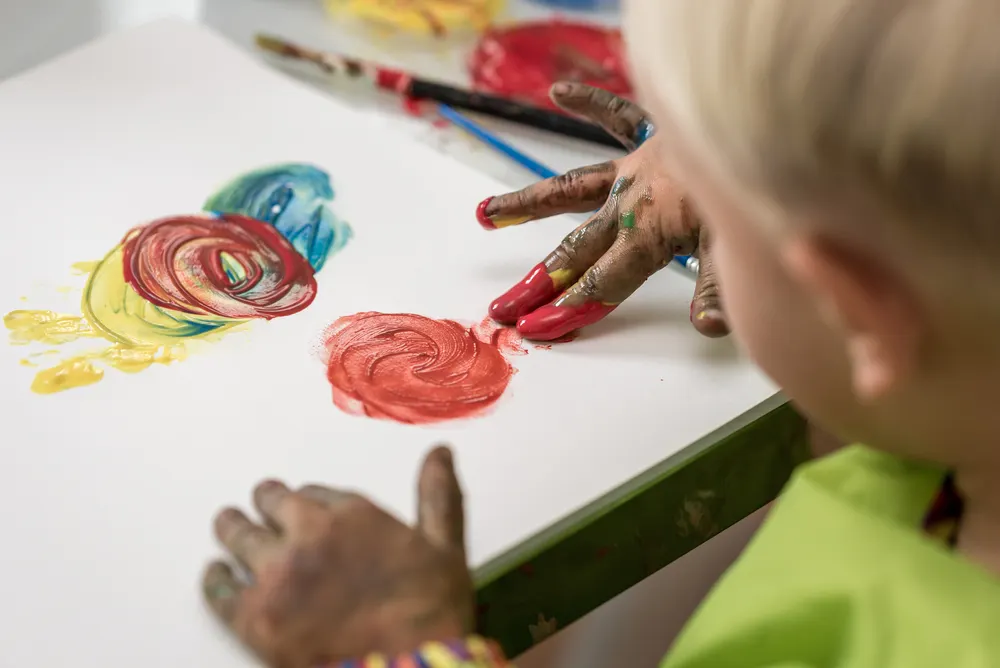
Art Activities: A Gateway to Sensory Play
Participation in art activities can significantly contribute to a child’s sensory play.
These activities provide a platform for children to express their creativity while improving their motor skills and cognitive development.
One such activity is playing with dough.
Dough play not only sparks creativity but also promotes calm and focus.
The squishing and building process allows children to explore various textures and shapes, granting them a unique sensory experience and enhancing their hand-eye coordination.
Finger painting is another art activity that encourages sensory exploration.
With every stroke, dab, or smear, children are introduced to different tactile sensations.
They feel the coolness of the paint, its fluidity, and the smoothness of the canvas beneath their fingers.
To make things more interesting and sensory stimulating, you can introduce other items into their finger painting routine, like water or pudding.
These items offer distinctive textures, changing the overall painting experience.
For instance, painting with pudding can be a deliciously tactile and aromatic experience.
Such variety in substances ensures that the child’s senses are continuously stimulated, encouraging curiosity and exploration.
Remember, the objective of sensory play is not the end product but rather the journey of discovery and learning.
Mealtime: A Sensory Exploration
Transforming mealtime into a sensory adventure can significantly enhance a child’s development and understanding of food.
Introducing a variety of foods with contrasting textures, colors, and aromas encourages toddlers to explore and appreciate diversity in what they eat.
For instance, the crunchiness of a fresh carrot, the smoothness of mashed potatoes, or the squishy texture of ripe bananas provide distinct tactile experiences that stimulate their curiosity.
Encouraging children to use their fingers to feel their food becomes a part of their learning process about new foods.
This tactile interaction not only fosters a better understanding of the food’s properties but also promotes a sense of independence and confidence in their feeding skills.
Further, a simple act like providing a small bowl of water and a washcloth at the end of the meal can be turned into a sensory activity.
Letting them clean their hands on their own turns the task of washing hands into a water play activity, providing additional sensory stimulation.
The feel of the water and the fabric of the washcloth contributes to building their tactile senses.
These hands-on experiences turn mealtime into a fun, sensory-rich learning opportunity, aiding their growth and development.
Sensory Toys and Books: Fun Learning Tools
Sensory toys and books provide a wealth of opportunities for stimulating a child’s senses while promoting learning and development.
Balls, for instance, are classic toys that can be incredibly sensory-rich.
They come in a variety of textures – smooth plastic, rough rubber, or soft plush.
Playing with different kinds of balls helps children discern between different tactile sensations and build hand-eye coordination.
Sensory books, especially ones with various textures embedded within the pages (like this one), serve as excellent learning tools.
These books often feature different materials to represent the illustrations, such as soft fur for an animal or rough fabric for a tree bark.
Such tactile elements encourage children to touch, feel, and explore, enhancing their sensory perception and vocabulary.
Simultaneously, the act of turning the pages improves their fine motor skills.
To make the most of these resources, one can combine storytime with sensory play.
As you read about a fluffy bunny, let the child touch and explore a soft stuffed animal, thereby linking the story with a tangible sensory experience.
In this way, sensory toys and books not only enrich playtime but also contribute significantly to a child’s cognitive and sensory development.
Make a Simple Sensory Bin
A sensory bin is a fun and engaging activity that can keep your child entertained and stimulated.
Creating a sensory bin is simple.
You’ll need a good-sized plastic container.
Fill the container with different materials like dry pasta, dry rice, cotton balls, or small toys.
These materials are excellent for encouraging your child’s sense of touch and facilitating messy play, which is a vital component of sensory exploration.
The beauty of sensory bins is that you can constantly switch out the items to sustain your child’s interest.
One day it could be filled with small toys and cotton balls and the next day it could be a shaving cream play paradise.
This variety ensures that your child is continually exploring new textures, shapes, and sizes, stimulating their curiosity and creativity.
However, a sensory bin requires close adult supervision to ensure the small items in the bin are safe and that your child doesn’t end up swallowing them.
Therefore, for children who tend to put everything in their mouths, an alternative solution is sensory bags.
Just grab a leak-proof, durable bag and fill it with a variety of materials that provide the same sensory experience as a bin but in a safer context.
In conclusion, whether you’re looking for sensory bin ideas or alternatives like sensory bags, the goal is to provide safe, stimulating, and engaging activities for your child.
Always remember, that the key to successful sensory play resides in exploration, creativity, and safety.

Grab your FREE Milestone Guide HERE.
Have fun exploring together!
Sensory play does not have to be complicated or messy.
With a touch of creativity and mindfulness, parents can transform ordinary daily encounters into exciting sensory explorations.
For instance, a sensory table can be a fun activity that doesn’t require extensive preparation or cleanup.
You could serve breakfast with a variety of textured foods, describe the feeling of the clothes while dressing up, or involve your child in household chores like sorting laundry by color and texture.
Great ideas for sensory play are often right under our noses, in the form of our favorite sensory activities, ready to boost your child’s development.
Frequently Asked Questions About Sensory Play
Sensory play simply refers to any activity that stimulates a child’s senses: touch, smell, taste, sight, and hearing.
These activities can range from playing with textures in a sensory bin to experiencing the taste of various foods.
Sensory play encourages children to explore and investigate their world, helping them to develop cognitively, linguistically, and emotionally.
Sensory play can be introduced as early as infancy.
Babies explore their world through their senses, so providing them with a variety of sensory experiences can have a positive impact on their development.
However, as with all activities with infants and young children, adult supervision is essential to ensure safety.
No, sensory play is beneficial for all children.
While it can indeed provide significant benefits for children with sensory processing disorders, it’s important to understand that sensory play aids in the overall development of every child by fostering curiosity, imagination, and exploration.
There’s no hard and fast rule about how frequently to include sensory play.
What’s important is to incorporate sensory experiences into your child’s daily routine, such as during bath time, mealtime, or while doing chores.
Remember, sensory play is all about exploration and fun, so make it a natural part of your child’s day.
Related Posts You Will Enjoy
How to Handle Toddler Screaming and Why it Happens
Complete Guide to the Best Toddler Climbers
What You Need to Know about the 2 Year Old Sleep Regression
The Best Ideas to Entertain Your Busy Toddler at Home
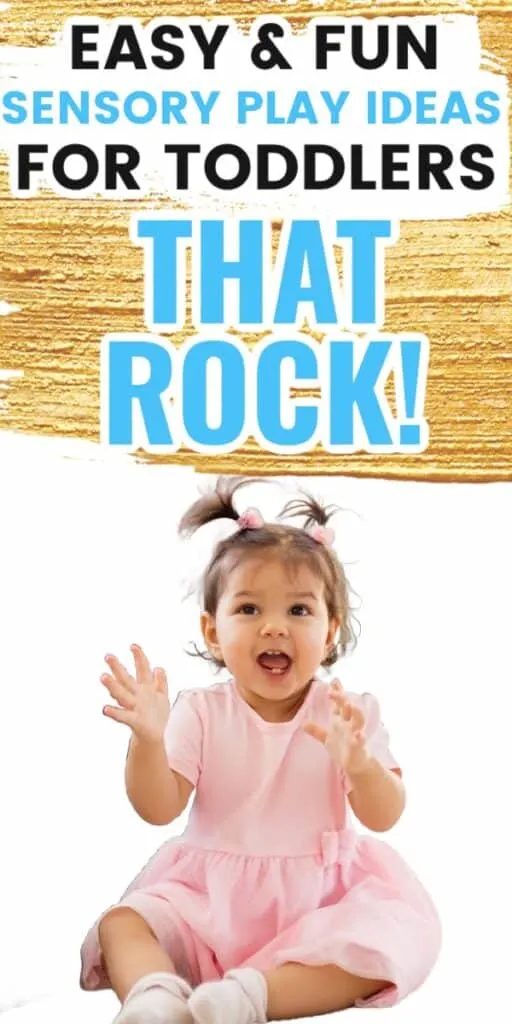

Kayla O’Neill has a master’s degree in education as well as a bachelor’s degree in special education with an emphasis in early childhood education. She has been working as a developmental therapist with babies and toddlers in early intervention since 2012. She is also a mom with two young children.
